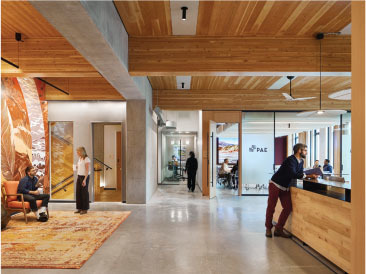July/August 2019
Communities: Private Practice
Thinking Like Your Clients
BY MEL LESTER
 Imagine a few of your clients decided to start their own A/E firm. They’ve had a lot of experience with firms like yours, so they have a pretty good idea of what’s involved. But these folks don’t want to start just another A/E firm. They want to do something substantially different—to create the kind of firm they wish they’d had the opportunity to work with. What would that firm look like? How might they do business differently?
Imagine a few of your clients decided to start their own A/E firm. They’ve had a lot of experience with firms like yours, so they have a pretty good idea of what’s involved. But these folks don’t want to start just another A/E firm. They want to do something substantially different—to create the kind of firm they wish they’d had the opportunity to work with. What would that firm look like? How might they do business differently?
If you want to know how to differentiate your A/E firm, retain more customers, and increase profits, the best advice I can offer is simply this: Think like your clients. Try to look at how you conduct every aspect of your business through their eyes.
The best way to understand how clients see your firm is to ask them. Here are a few examples of how clients think based on the hundreds of interviews I’ve conducted:
Don’t call me unless you have something specific to offer. You should know how it feels to be on the receiving end of a cold call. Yet you call me out of the blue wanting to introduce me to your firm. If you want to talk with me, do a little homework to understand my current needs and call only when you can offer information specific to my problem.
Respect my time. If you want to meet with me, give me something more than the usual drop-by sales call or unfocused project meeting. Come prepared to deliver what you promised when you called—real help in solving my problem. And don’t take more time than is necessary; keep the chit-chat to a minimum.
Don’t expect me to read your whole proposal. Do a total word count for your document and divide that by 250, which is about the number of words the average American adult reads per minute. So, do you really think I’m going to spend over an hour reading your proposal or report? No, I think you know I’m going to skim and search for the information I’m looking for. Make your document more skimmable and give me a well-written and -illustrated executive summary that covers its most important points.
Tell me when you can actually deliver the project, not what you think I want to hear. I know this is a little confusing. I pressed you to commit to an ambitious deadline that you probably knew you couldn’t make. But you said you could and made me happy for a while. Now it’s crunch time and your deliverable is late. If you had said no at the start, I could have adjusted the overall project schedule—even though I wouldn’t be happy about it. Now I’m in a real bind.
Don’t wait to tell me about a problem until it’s a big one. Project problems don’t usually go away by ignoring them. They get worse. I want you to tell me when you see a problem developing so we can intervene before it gets out of hand. Better yet, anticipate when a problem might arise so we can consider some proactive steps to prevent it from occurring.
Don’t just communicate with me on a need-to-know basis. I almost hate to hear from you because it’s usually bad or late news. Yeah, I’m busy and don’t want to be bothered with trivial updates. But I don’t like hearing about important developments after the fact. That sometimes leaves me with few, if any, options for responding to the situation. Give me a chance to be proactive.
Understand my business. It’s not just an engineering project; it’s a business move designed to address financial, operational, or competitive issues critical to our success. Sometimes you don’t seem to make the connection. You focus on the technical issues that you’re interested in and overlook the business drivers that I need to respond to. I don’t just need a designer or specialty consultant; I need a problem solver who can see the whole picture.These are just a few of the perspectives I’ve gained from clients over the years. None of them are hard to understand if you imagine yourself in the client’s role. If you want to raise the value of your services, try mixing more empathy with your expertise.
Mel Lester, of management consulting firm BizEdge, specializes in helping engineering, architectural, and environmental firms improve business performance in areas such as leadership, strategic planning, project delivery, business development, customer service, and human resources. He can be reached at [email protected].


 Volunteering at NSPE is a great opportunity to grow your professional network and connect with other leaders in the field.
Volunteering at NSPE is a great opportunity to grow your professional network and connect with other leaders in the field. The National Society of Professional Engineers (NSPE) encourages you to explore the resources to cast your vote on election day:
The National Society of Professional Engineers (NSPE) encourages you to explore the resources to cast your vote on election day:






